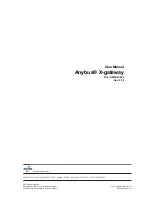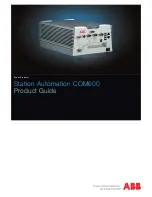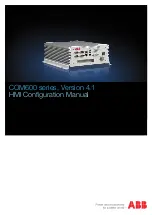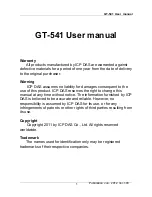
Doc: HMSI-27-262, Rev: 2.10
Anybus X-gateway User Manaul
Chapter 2
2. Basic Operation
2.1 Data Exchange
Each of the two network interfaces exchange data on it’s network through two buffers. The gateway
forwards the data between these buffers as shown below. Note that this process is separated from the
network data exchange; while the gateway ensures data consistency (where applicable), it does not fea-
ture any built-in mechanisms for synchronisation between the two networks.
Each buffer holds up to 512 bytes of data, which is the theoretical upper limit for the number of bytes
that can be exchanged in each direction. Note however that the actual number of bytes that can be ex-
changed is highly network dependent.
Besides network I/O, these buffers are optionally also used to provide access to network status infor-
mation, and to control various aspects of the gateway. This may be general diagnostic information (called
the ‘Status Word’), list of active slaves (known as the ‘Live List’), or other network specific status infor-
mation. A dedicated Control Word may be used to start/stop the exchange of data, or to reset the gate-
way if needed.
Most networks distinguishes between fast cyclical I/O and less time critical acyclic data. Where applica-
ble, this is also reflected in how data is treated by the gateway and the on-board network interfaces.
The amount of data that shall be exchanged, and the use of the control- and status functionality, is spec-
ified separately for each network via the Gateway Config interface. This means that even though up to
512 bytes of data can be forwarded to an interface, the amount of data that will actually be exchanged
on that network is determined by settings in the network interface itself. While this may not seem logical
at first, it allows data exchange regardless of network specific needs and limitations.
Note that the available control- and status functionality highly depends on the actual gateway configu-
ration. Also note that the terminology and definitions used for different types of data varies greatly be-
tween different networking systems. In this document, they are simply referred to as ‘I/O Data’ (as in
fast, cyclic data) and ‘Parameter Data’ (as in acyclic, slow data).
See also...
• See also “Status & Diagnostics” on page 11.
• See also “Controlling the Gateway from the Network” on page 13.
• See also “Data Mapping” on page 14.
Network Interface 2
Network Interface 1
Network 2
Network 1
Data From
Network 2
Data From
Network 1
Data From
Network 1
Data From
Network 2






































